Development of high-precision radiotherapy – Department of Therapeutic Radiology, Graduate School of Medicine Professor Keiko Shibuya
Radiation technology has been advanced along with developments of IT (Information Technology). Prof. Shibuya is now working on the research field of new development strategies for lung and abdominal tumors, by using the leading-edge tumor-tracking radiotherapy system, an early prototype of which was introduced to Yamaguchi University.

Graduate School of Medicine
Professor
Keiko SHIBUYA
| 2011: | Assumed the position of Professor at the Department of Radiation Oncology , Graduate School of Medicine, Yamaguchi University upon the establishment of a new Department of Radiation Oncology |
| 2010: | Lecturer at Graduate School of Medicine, Kyoto University |
| 2002 to 2004: | Assistant Professor at MD Anderson Cancer Center, USA |
| 2001: | Assistant Professor at Graduate School of Medicine, Kyoto University |
| 1991: | Graduated from Faculty of Medicine, Kyoto University Development |
Introduction: What is therapeutic radiology?
Therapeutic radiology is an academic field in which cancers are treated on the basis of the rationale of radiation oncology, which can target almost all malignant tumors in systemic organs. Novel treatment methods are being developed and researched.The history of radiotherapy began with the discovery of X-rays by Roentgen in 1895. Surprisingly, only 1 year after this discov-ery, X-ray treatment was attempted. Thereafter, radiation biology and radiation physics were developed separately on the basis of the characteristics of radiation. These two academic fields were then integrated with oncology, resulting in a single academic system, namely radiation oncology.Radiation technology has advanced along with the development of information technology, and today, radiotherapy has become indispensable as part of the cancer treatment triad (i.e., radiotherapy, surgery, and chemotherapy). In addition, radiotherapy plays an important role, not only as monotherapy but also as part of multimodal treatment, and is involved in a wide range of cancer treatments, from radical to palliative.Novel radiotherapy techniques need to be researched and devel-oped from the perspective of both radiation biology and radiation physics. We must have a thorough basic and clinical knowledge of tumors and radiation characteristics, and at the same time we must be capable of accurately assessing the characteristics of each tumor and the pathological conditions of patients.
Cancer radiotherapy
In radiotherapy, the use of three-dimensional conformal radiotherapy (3D-CRT), which can selectively target tumors both three-dimensionally and multi-directionally, has greatly improved therapeutic effects and reduced side effects.Furthermore, the development and introduction of high-preci-sion radiotherapies such as stereotactic body radiation therapy (SBRT) (Figure 1) and intensity-modulated radiation therapy (IMRT) (Figure 2) have improved prognosis and reduced adverse events in patients with early lung, prostate, or head and neck cancers. IMRT is very useful for ensuring tumor selectivi-ty, because it can be used to achieve dose distributions with complex shapes by changing the shape of the radiation field little by little during irradiation.However, higher accuracy is required because of the complexi-ty of SBRT and IMRT; especially in treating tumors such as those of the lung or liver, the positions of which constantly change with respiration during irradiation, we must fully under-stand that dose distributions to such tumors can be inaccurate, and accordingly we need to take appropriate measures.
Stereotactic body radiation therapy (SBRT)SBRT can target tumors three-dimensionally and multi-directionally within 5-mm accuracy; it is also called “pinpoint irradiation”.
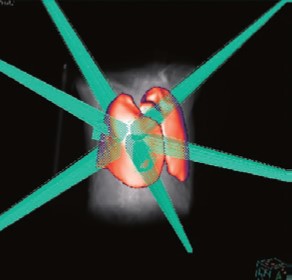
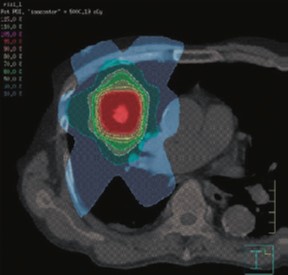
SBRT for early-stage lung cancer. SBRT can be used to deliver a high dose of radiation concentrated on a small area. This results in a strong biological effect (antitumor effect), resembling sharp excision with a surgical knife.
ntensity-modulated radiation therapy (IMRT)
IMRT yields dose distributions with more complex shapes. This method can be used to deliver high doses of radiation to a tumor safely, while sparing the adjacent normal organs and thus minimizing the risk of adverse events (i.e. side effects).
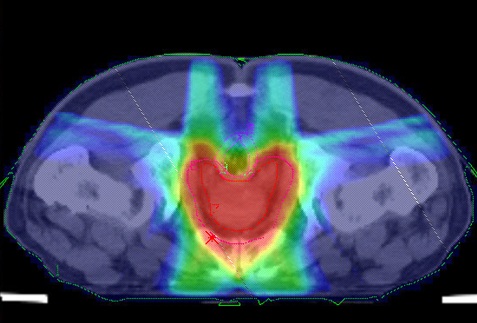
Radiotherapy for prostate cancer: IMRT can be used to deliver a high dose of radiation selectively to the prostate gland while sparing the rectum, thus achieving treatment outcomes similar to those of surgery. When the tumor is medically treatable by either surgery or radiotherapy, patients are, in principle, free to choose one of these alternatives.
In recent years, research and development have been conduct-ed on a four-dimensional irradiation system capable of dealing with tumors that move with respiration.
Real-time tumor-tracking radiotherapy (RTRT) delivers radia-tion during the observation of tumor motion three-dimensional-ly. Yamaguchi University Hospital introduced this technology to Japan early on and has so far treated many patients by SBRT using the RTRT system.
We have applied craniocaudal positional information on tumors to an existing dynamic phantom and have developed a quality assurance program for four-dimensional radiotherapy. We con-firmed that the accuracy in tracking mobile tumors 3 cm or less in diameter was within 2 mm. High-precision treatment was able to be provided with high dosimetric and geometric accura-cy equivalent to those in the treatment of immobile tumors.
Furthermore, in 2015, we started the world’s first radiotherapy system (Figure 3) that uses a new real-time tracking system (Sync-Trax) and a radiotherapy system (TrueBeam)which has the potential to deliver radia-tion up to about 10 times faster per unit time than conventional systems.
The IMRT irradiation method is more complicated than that of SBRT; therefore, it is still difficult to use IMRT on mobile tumors. We analyzed the motion of the pancreas and developed an IMRT method with an expiratory breath-hold system. By using this method, we conducted dose-escalation stud-ies in pancreatic cancer and recognized good therapeutic out-comes. In addition, we are now studying the application of the above-mentioned latest real-time tracking system to IMRT. Be-cause verification is very important for securing accuracy, in collaboration with the Faculty of Engineering, Yamaguchi Uni-versity, we are developing a new system of verification.
■Figure 3
Stereotactic body radiation therapy (SBRT)SBRT can target tumors three-dimensionally and multi-directionally within 5-mm accuracy; it is also called “pinpoint irradiation”.
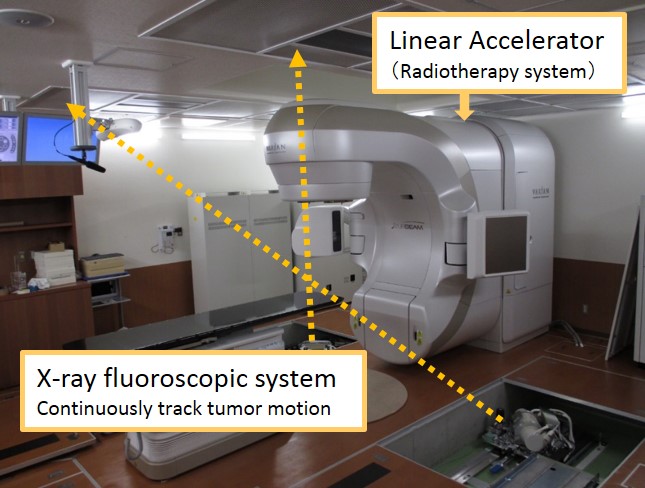
Gold markers are placed close to the tumor in the body, and two sets of fluoroscopy is used to identify the three-dimensional position of the markers and track them continuously. In this way, tumor motion during respiration is recognized in real time, and radiation can therefore be delivered accurately in synchrony with respiration.
Future goals of radiotherapy
In the US, two-thirds of cancer patients receive radiotherapy. Curerently, half of all Japanese will develop cancer. From this perspective, developing human resources involved in radiother-apy should be regarded as a mainstay of cancer control. Furthermore, in Japan, which faces an aging population and declining birth rate, developing and providing cancer treatments for those who continue working, as well as elderly-friendly cancer treatments, are top priorities. Therefore, experts in all fields, including surgeons, physicians, radiothera-py physicians, palliative care physicians, nurses, and pharma-cists, must get together to work on cancer treatment. With the aim of creating forward-looking clinical, research, and education-al environments, I would like to continue to provide new information on cancer treatment from Yamaguchi.
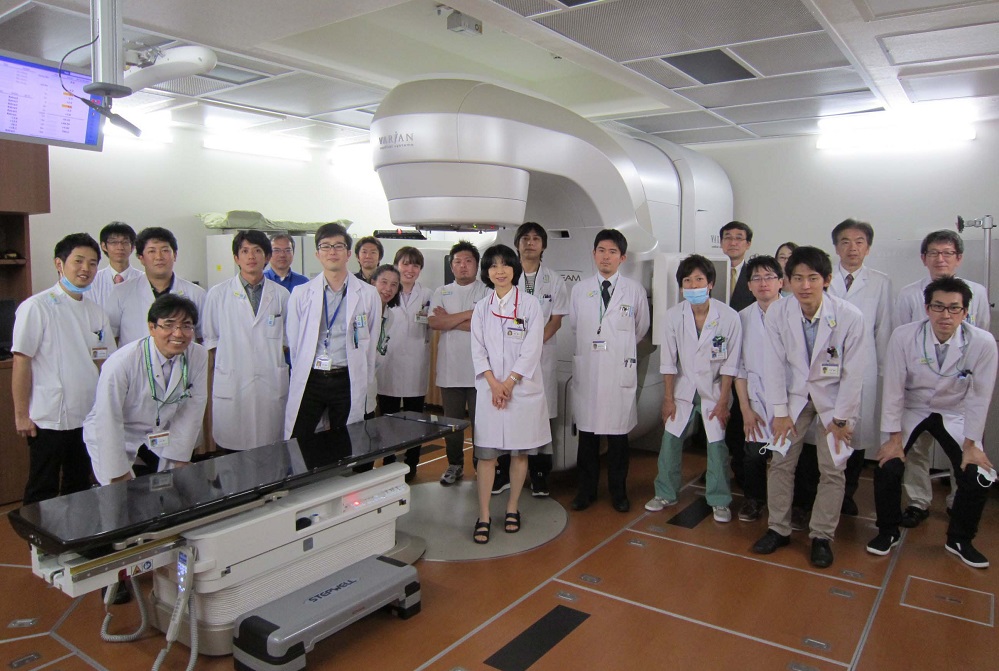
We have successfully treated the first patient in the world treatment system using the high-accuracy linear accelerator and latest real-time tracking radiotherapy system (TrueBeam and SyncTrax). The photo shows staff involved in the system’s development and treatment.